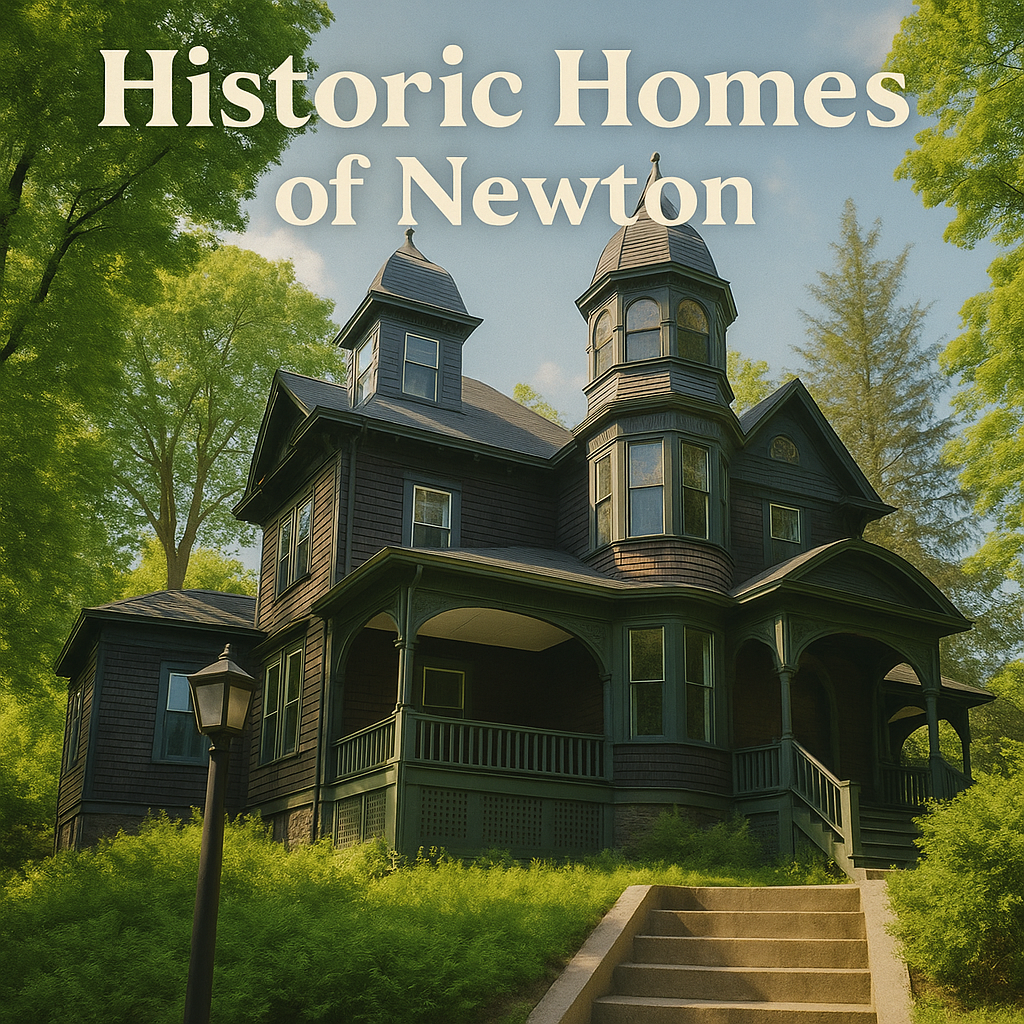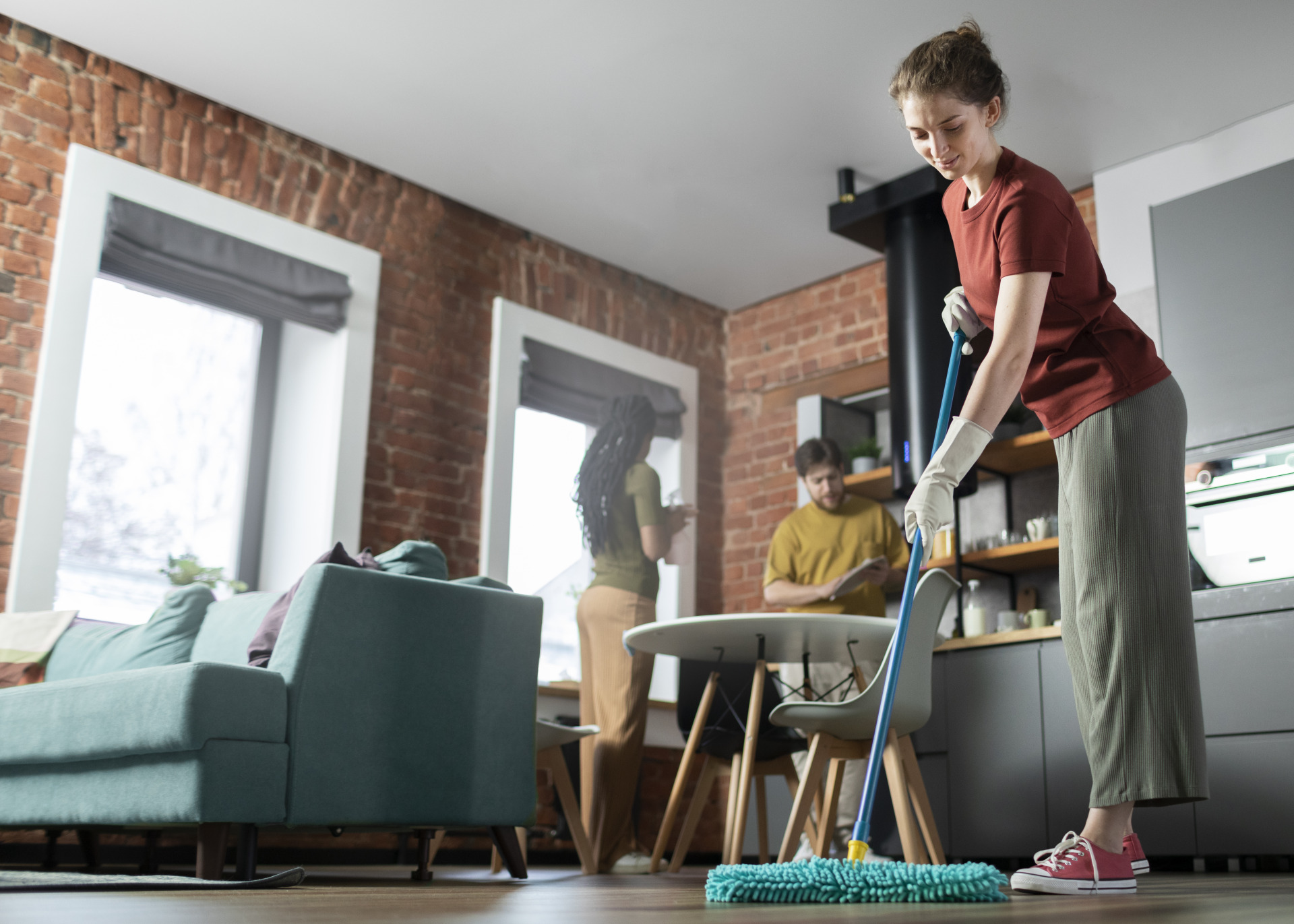Newton stands as one of Massachusetts’ most architecturally significant communities, where nearly half of all homes were built before 1940. These historic properties—ranging from elegant Colonial Revivals to charming Tudor estates—require specialized cleaning approaches that protect their distinctive character while maintaining modern standards of cleanliness. Whether you own a century-old home in Newton Centre or a vintage property near Newton Highlands Station, understanding proper care techniques ensures your investment remains pristine for generations to come.
Newton’s Architectural Heritage: A Community Built on History
According to U.S. Census data, 49.7% of Newton homes were built before 1940, with a median construction year of 1940. This remarkable statistic places Newton among the most historically significant residential communities in the Greater Boston area, with architectural treasures spanning from the late Victorian era through the Arts and Crafts movement.
These pre-war homes represent an era of superior craftsmanship—featuring solid hardwood floors, hand-applied plaster walls, original tile work, and intricate woodwork that modern construction rarely replicates. Our team has provided deep cleaning services throughout Newton, from Hammond Pond Parkway to Cummings Road, and we’ve learned that these architectural gems demand specialized attention.
What makes Newton’s historic homes unique:
The architectural diversity across Newton’s 13 villages reflects distinct building periods and styles. Properties in Chestnut Hill often showcase Tudor Revival and Colonial Revival architecture, while Newton Centre features stunning examples of Craftsman and Four-Square homes. Waban and Newton Highlands display beautiful Victorian and Queen Anne structures, each with distinctive cleaning requirements.
Newton’s median home value of $1,268,950 reflects not just real estate market dynamics but the extraordinary value homeowners place on preserving these architectural treasures. When we completed our recent project near Newton City Hall, the homeowner specifically requested techniques that would honor the home’s 1920s character while achieving modern cleanliness standards.
Understanding the Unique Challenges of Historic Home Cleaning
Older homes present cleaning challenges that newer construction doesn’t face. Materials age differently, original finishes require gentler care, and historical construction methods create hidden dirt traps that modern homes avoid through design.
Original hardwood floors: Pre-1940 homes typically feature solid hardwood flooring—often oak, maple, or pine—installed over traditional subflooring rather than plywood. These floors have survived decades of foot traffic, but their finish layers may be thinner than you realize. Our house cleaning services in Newton specifically address these concerns using pH-neutral cleaners that won’t strip historic finishes.
During a transformation project on Watertown Street, we encountered 90-year-old floors that previous cleaners had damaged with harsh alkaline solutions. The restoration required careful attention to preserve the remaining original finish while removing decades of buildup.
Plaster walls versus drywall: Homes built before the 1950s feature hand-applied plaster over wooden lath, creating walls with texture and character impossible to replicate with modern drywall. However, these walls are more porous and can absorb moisture from cleaning solutions, potentially causing damage. When providing deep cleaning near the historic playground in Newton Centre, we encountered original plaster that required specialized techniques to avoid water damage while removing years of accumulated grime.
Historic tile and fixtures: Original bathroom and kitchen tiles from the 1920s and 1930s often feature patterns and colors no longer manufactured. These tiles may have grout that’s nearly a century old, requiring gentle cleaning to avoid erosion. Our experience with polished kitchens and bathrooms throughout Newton has taught us that preservation must balance with sanitation—especially in high-moisture areas.
Period woodwork and moldings: Crown moldings, baseboards, window casings, and built-in cabinetry in pre-war homes showcase craftsmanship rarely seen today. These elements often feature original paint or varnish that decades of improper cleaning can damage. During same-day cleaning requests near Crystal Lake, we’ve encountered everything from original shellac finishes to early lacquers, each requiring specific care approaches.
Old glass windows: Historic single-pane windows lack the UV protection and insulation of modern glass, but they possess character and clarity that homeowners cherish. These windows often sit in original wood frames that need careful cleaning to prevent moisture intrusion that could cause rot. The wavy, hand-rolled glass found in the oldest Newton homes requires gentle techniques to avoid scratching or etching.
What NOT to Do: Protecting Your Historic Home from Damage
Learning what to avoid proves as important as knowing proper techniques. Modern cleaning products and methods, while effective on contemporary materials, can irreversibly damage historic home elements.
Avoid harsh alkaline cleaners on wood: Many conventional floor cleaners contain strong alkaline compounds that strip original finishes from hardwood. These products may promise quick results but gradually destroy the protective layers that have preserved your floors for decades. We learned this lesson early in our service to Newton homeowners—now we exclusively use pH-balanced solutions for historic wood surfaces.
Never use abrasive scrubbers on original tile: Steel wool, abrasive sponges, and scouring powders can permanently scratch vintage tile glazes and erode century-old grout. When we performed a recent deep cleaning project that left a lasting impression, the homeowner had previously attempted aggressive scrubbing on 1930s bathroom tile, leaving permanent scratches. Gentle techniques and appropriate cleaners achieve superior results without damage.
Don’t saturate plaster walls: Excessive moisture penetrates porous plaster, potentially causing the material to delaminate from its lath backing. When cleaning walls in pre-war homes, we use barely-damp microfiber cloths and work in small sections, allowing each area to dry before proceeding. This approach, which we employ during apartment cleaning services throughout Newton, prevents the moisture damage that ruins original plaster.
Avoid ammonia-based products on vintage fixtures: Brass, bronze, copper, and nickel-plated fixtures common in pre-1940 homes can tarnish, corrode, or lose their finish when exposed to ammonia. Many glass cleaners contain ammonia, making them unsuitable for historic bathrooms with original mirrors mounted in decorative metal frames.
Never use steam cleaners on old wood floors: While steam cleaning works well on modern engineered floors with protective polyurethane finishes, the intense heat and moisture can warp or damage solid hardwood planks and compromise shellac, varnish, or oil finishes common in historic homes. Our deep cleaning services employ methods appropriate to each floor’s age and finish type.
Don’t pressure wash historic exteriors: Although pressure washing efficiently cleans modern vinyl or composite siding, the same pressure destroys vintage painted wood siding, erodes mortar between bricks, and forces water behind clapboards where it causes rot. Newton homes with original exterior materials require gentler approaches.
Room-by-Room Historic Home Cleaning Guide
Each space in a pre-1940 home presents distinct challenges and opportunities. This comprehensive approach ensures thorough cleaning while preserving historical integrity.
Living Spaces: Preserving Character While Removing Dust
Living rooms, dining rooms, and parlors in historic homes typically feature the finest architectural details—original hardwood floors, decorative plasterwork, built-in bookcases, and period light fixtures. These spaces showcase your home’s character and require careful attention.
Floor care: Begin by thoroughly sweeping or dust-mopping to remove grit that could scratch finishes. For solid hardwood, use a barely-damp microfiber mop with pH-neutral cleaner specifically formulated for wood. Work in the direction of the grain, and never allow water to pool or sit on the surface. During our work throughout Newton, we’ve found that monthly deep cleaning maintains historic floors beautifully when combined with regular dry mopping.
Wall and ceiling cleaning: Historic plaster develops a patina over time—a subtle sheen that adds character. Use a soft, dry microfiber cloth or duster for routine cleaning. For marks or stains, spot-clean with a slightly dampened cloth using minimal pressure. Never scrub aggressively, as this can damage the plaster surface or remove historic paint layers.
Woodwork maintenance: Crown moldings, baseboards, door frames, and window casings accumulate dust in their decorative details. A soft-bristled brush attachment on your vacuum works well for regular maintenance. For deeper cleaning, use a barely-damp cloth with a mild, oil-free soap solution. Dry immediately with a clean cloth to prevent moisture damage. We apply these techniques during recurring cleaning services for Newton’s historic homes.
Built-in cabinetry: Original built-ins—whether bookcases, window seats with storage, or display cabinets—often feature glass panels and intricate wood details. Remove all items, vacuum thoroughly, and clean glass with vinegar-water solution. Polish wood surfaces according to their finish type: shellac responds well to furniture oil, while painted surfaces need only gentle soap and water.
Kitchens: Balancing Sanitation with Preservation
Historic kitchens have often undergone partial updates—perhaps modern appliances installed while original cabinets, floors, or tile remain. This mixture of old and new requires flexible cleaning approaches.
Original cabinetry: Pre-war kitchen cabinets typically feature solid wood construction with period hardware. Clean cabinet exteriors with mild soap and water, drying immediately. Pay special attention to areas near the stove where grease accumulates. For our polished kitchens throughout Newton, we use degreasers safe for old finishes, testing in inconspicuous areas first.
Vintage tile countertops or backsplashes: If your kitchen retains original tile, treasure it—such installations are increasingly rare. Clean with pH-neutral tile cleaner and a soft cloth or sponge. Avoid acidic cleaners (including vinegar) on grout, which can cause erosion over time. For stubborn grout stains, use a paste of baking soda and water applied gently with an old toothbrush.
Historic sinks: Porcelain sinks from the 1920s-1940s may show crazing (fine surface cracks) but remain functional. Clean with non-abrasive cream cleansers designed for porcelain. Never use bleach, which can cause yellowing, or abrasive powders that scratch the finish. Cast iron sinks with porcelain enamel require similar gentle treatment.
Floor transitions: Many historic kitchens feature different flooring than adjacent rooms—perhaps linoleum (a natural product made from linseed oil) or tile where the rest of the home has hardwood. Use appropriate cleaners for each surface, taking care at transitions to avoid moisture damage to wood.
Bathrooms: Addressing Moisture While Protecting Original Features
Bathrooms in pre-1940 homes often retain the most original features—tile walls, pedestal sinks, claw-foot tubs, and intricate floor patterns. These spaces require special attention due to constant moisture exposure combined with historic materials.
Vintage tile walls: Original bathroom tile, whether white subway tile or colorful period patterns, has survived decades because of proper care. Clean with pH-neutral tile cleaner, working in sections. For soap scum on shower tiles, a paste of baking soda and water provides gentle abrasion without scratching. Rinse thoroughly and squeegee or towel-dry to prevent water spots. This approach has proven effective in bathroom deep cleaning projects throughout Newton.
Historic fixtures: Pedestal sinks, exposed piping, and vintage faucets add character but collect soap residue and water deposits. Clean porcelain fixtures with non-abrasive cleansers. For chrome or nickel-plated faucets, use mild soap and water, drying immediately to prevent spotting. Avoid harsh chemicals that can damage plating or cause corrosion underneath.
Claw-foot tubs: These iconic fixtures, whether original porcelain or cast iron with enamel finish, require regular but gentle cleaning. Use non-abrasive bathroom cleaner applied with a soft cloth or sponge. For stains, make a paste of hydrogen peroxide and cream of tartar, let it sit briefly, then rinse thoroughly. Clean the exterior and feet, as dust and grime accumulate in decorative details.
Original floor tile: Historic bathroom floors often feature small hexagonal tiles, penny rounds, or decorative borders. These installations may have grout that’s 80-100 years old. Clean regularly with pH-neutral cleaner and soft mop. Address grout with care—aggressive scrubbing or harsh chemicals can erode it, leading to costly repairs. During our deep cleaning services, we’ve developed specialized approaches for each grout type common in Newton’s pre-war homes.
Ventilation concerns: Older bathrooms may lack adequate ventilation, making moisture management crucial. Always run exhaust fans (if present) during and after showers. Wipe down surfaces to remove standing water. This prevents mold growth while protecting original materials from excessive moisture exposure.
Bedrooms: Gentle Care for Private Spaces
Historic bedrooms typically feature simpler architectural details than public spaces but still require appropriate cleaning techniques.
Closet interiors: Pre-war closets are often smaller than modern standards and may have original cedar lining or painted shelves. Vacuum thoroughly, including corners where dust accumulates. For cedar closets, avoid wet cleaning—the wood’s natural oils provide moth protection, and moisture can compromise this. In painted closets, wipe shelves with barely-damp cloth and mild soap solution.
Window treatments: Historic homes may retain original wood shutters, vintage curtain rods, or built-in window seats. Dust shutters regularly with soft cloth. Clean window seat cushions according to fabric type, and vacuum beneath cushions where dust collects. During house cleaning services for Newton homes, we pay special attention to these often-overlooked areas.
Radiators and heating elements: Pre-war homes typically have hot water or steam radiators—beautiful cast iron elements that accumulate dust in their fins and decorative details. Vacuum between fins using a narrow attachment, then wipe exteriors with damp cloth. Never paint over radiator valves or moving parts during redecorating, as this interferes with temperature control.
Seasonal Maintenance for Historic Properties
Newton’s climate—with cold, snowy winters and humid summers—affects historic homes differently than modern construction. Seasonal maintenance protects your investment year-round.
Spring deep cleaning: After winter, when homes have been sealed tight for months, spring presents the ideal time for comprehensive cleaning. Open windows for ventilation (weather permitting), allowing fresh air to circulate. Focus on areas where winter dust accumulates: radiators, window sills, and corners. This is when many Newton homeowners schedule deep cleaning services to refresh their homes.
Summer humidity management: Humid summer air can affect historic plaster, wood, and paint. While cleaning, monitor humidity levels—ideally 30-50% relative humidity. Dehumidifiers help in basements and other damp areas. Clean and inspect areas prone to moisture issues: basement walls, under sinks, around windows. Addressing small issues prevents major problems.
Fall preparation: Before heating season begins, clean radiators thoroughly, check window weather-stripping, and address any air leaks that let in cold drafts. Clean gutters and downspouts to prevent water damage during fall rains and winter snow melt. Many homeowners in Brookline, Needham, and Newton request fall cleaning specifically to prepare historic homes for winter.
Winter care: During heating season, maintain humidity levels to prevent wood shrinkage and plaster cracking. Clean around heat sources regularly, as forced air and radiators circulate dust. Check for ice dams, which can force water under roofing and damage ceilings. Wipe condensation from windows promptly to prevent sill damage and mold growth.
Newton Village Spotlight: Architectural Styles and Their Cleaning Needs
Each of Newton’s 13 villages developed distinct architectural characters, and understanding these differences helps homeowners provide appropriate care.
Newton Centre and Newton Highlands: These villages showcase substantial Colonial Revival and Craftsman homes with complex rooflines, multiple porches, and detailed woodwork. These properties benefit from quarterly deep cleaning to maintain intricate details. We’ve completed projects near Newton Highlands Station and by the historic playground in Newton Centre where attention to architectural details made all the difference.
Chestnut Hill: Known for larger estates and Tudor Revival homes, this area features homes with stucco exteriors, decorative half-timbering, and casement windows. Interior spaces often include dark wood paneling and beamed ceilings that require specific cleaning approaches to prevent darkening the wood further.
Waban and West Newton: These villages contain beautiful Victorian and Queen Anne homes with wrap-around porches, decorative shingles, and painted details. These homes have numerous nooks and architectural elements where dust collects—regular cleaning prevents buildup that becomes difficult to remove.
Auburndale and Newtonville: With more modest but still historically significant homes, these villages feature many well-preserved examples of early 20th-century architecture. Properties here often maintain more original features than homes that underwent extensive renovations, making appropriate cleaning techniques especially important.
Newton Corner and Nonantum: These eastern villages include diverse housing stock from different eras. Many homes underwent updates in the 1950s-1970s, creating combinations of historic and mid-century elements requiring flexible cleaning approaches.
Preservation-Friendly Cleaning Products and Tools
The right products and tools make historic home cleaning safer and more effective. While many cleaners work acceptably on modern surfaces, historic materials demand more careful selection.
For wood floors: Choose pH-neutral cleaners specifically formulated for hardwood. Avoid oil soaps on polyurethane-finished floors, but consider them for older oil or wax finishes. Test any new product in an inconspicuous area first. We use professional-grade wood cleaners during recurring cleaning services that protect historic floors while maintaining cleanliness.
For plaster walls: Simple solutions work best—mild dish soap and water for spot cleaning, or just damp microfiber cloths for dusting. Avoid products containing strong solvents or abrasives. For painted plaster, ensure paint has fully cured (typically 30 days) before wet cleaning.
For historic tile: pH-neutral tile cleaners prevent grout erosion and tile damage. For natural stone tile (marble, limestone, slate), use products specifically formulated for stone—acidic cleaners etch these surfaces. Baking soda paste provides gentle abrasion for stubborn spots without scratching.
For vintage fixtures: Mild liquid dish soap and water clean most historic bathroom and kitchen fixtures safely. For chrome or nickel plating, dry immediately after cleaning to prevent water spots. Avoid ammonia-based products that can damage plating.
For windows: Simple vinegar-water solution (1:1 ratio) cleans historic glass effectively without harsh chemicals. For very old wavy glass, use minimal pressure—these windows may be fragile. Dry with lint-free cloths or crumpled newspaper for streak-free results.
Essential tools: Invest in quality microfiber cloths, soft-bristled brushes, and gentle sponges. A good vacuum with adjustable suction and various attachments proves invaluable for historic homes. Avoid steam cleaners on most historic surfaces. During deep cleaning projects like our Hammond Pond Parkway transformation, proper tools make all the difference.
When to Call Professionals vs. DIY Cleaning
Understanding when to handle cleaning yourself versus hiring professionals protects your historic home while managing costs effectively.
DIY maintenance cleaning: Regular dusting, sweeping, mopping with appropriate products, and spot cleaning falls within most homeowners’ capabilities. Maintain a weekly or bi-weekly routine to prevent buildup that becomes harder to remove. This regular care, combined with seasonal deep cleaning, keeps historic homes in excellent condition.
Professional deep cleaning: Schedule professional services quarterly or semi-annually for comprehensive cleaning that reaches areas difficult for homeowners to access. Professionals understand historic material properties and use appropriate techniques for each surface type. Our deep cleaning services in Newton specifically address historic home needs, from Walnut Street properties to Cummings Road residences.
Specialized situations requiring professional help:
Pre-sale cleaning before listing your Newton home—professional results showcase property value and may impact sale price significantly given Newton’s median home value of $1,572,444.
Post-renovation cleaning after updating kitchens, bathrooms, or other spaces—construction dust infiltrates everywhere and requires thorough removal to protect both new and original elements.
Move-in or move-out cleaning—whether you’re purchasing a historic Newton property or preparing one for new occupants, professional cleaning ensures thorough coverage. For move-out situations, proper cleaning helps protect your security deposit under Massachusetts law.
Annual deep cleaning of difficult areas—high ceilings, elaborate crown moldings, crystal chandeliers, and other challenging elements benefit from professional expertise and equipment.
Same-day or emergency cleaning needs—when hosting important events or unexpected guests, professional services provide quick, comprehensive results. We offer same-day cleaning services throughout Newton for urgent situations.
Cost Considerations for Historic Property Maintenance
Newton homeowners invest significantly in their properties, and understanding cleaning costs helps budget appropriately for historic home care.
Historic home cleaning may cost slightly more than standard service due to:
Specialized knowledge requirements: Cleaners must understand period materials, appropriate products, and techniques that protect rather than damage original elements.
Additional time needed: Historic details require careful attention—you can’t rush past intricate woodwork, vintage tile, or delicate plaster without risking damage.
Premium products: Preservation-appropriate cleaning solutions often cost more than conventional cleaners, but they prevent expensive repairs caused by inappropriate products.
Insurance and expertise: Professional services specializing in historic properties carry appropriate insurance and train staff in specialized techniques.
Return on investment: Proper historic home maintenance protects your substantial investment. With Newton home values averaging over $1.5 million, appropriate care proves cost-effective compared to repairs from damage caused by improper cleaning.
Consider professional cleaning as preventive maintenance—protecting original plaster costs far less than replastering damaged walls. Maintaining historic floors with appropriate care preserves them indefinitely, while damage from harsh cleaners necessitates expensive refinishing or replacement.
Many Newton homeowners find that combining DIY maintenance cleaning with professional deep cleaning services provides optimal results at reasonable cost. We offer recurring cleaning services that can be customized to your historic home’s specific needs and your budget.
Protecting Newton’s Architectural Legacy
Newton’s pre-1940 homes represent irreplaceable architectural heritage. According to the U.S. Census, with 49.7% of the city’s housing stock built before 1940, homeowners collectively serve as stewards of this historic community character.
Every time you clean your historic Newton home thoughtfully—using appropriate techniques and products, respecting original materials, and addressing issues promptly—you contribute to preservation efforts that extend far beyond your property lines. These homes connect us to Newton’s past while providing beautiful, functional living spaces for contemporary life.
Whether you own a grand Colonial Revival in Chestnut Hill, a charming Craftsman bungalow in Newton Centre, or a vintage condo near Watertown Street, your home deserves care that honors its history while meeting modern cleanliness standards.
Our team has served Newton’s historic properties for years, from Rogers Street near Crystal Lake to properties near Newton City Hall. Each project teaches us more about these remarkable homes and reinforces our commitment to preservation-appropriate cleaning techniques.
For professional historic home cleaning in Newton, Brookline, Wellesley, Needham, and surrounding communities, contact BraBos Cleaning. We understand that your historic home isn’t just a building—it’s an irreplaceable piece of architectural heritage that deserves expert care.
BraBos Cleaning provides professional house cleaning, deep cleaning, move-in/move-out cleaning, and recurring cleaning services throughout Newton, MA and the Greater Boston area. Our team specializes in historic property care, bringing expertise and appropriate techniques to pre-1940 homes throughout Newton’s 13 villages.







